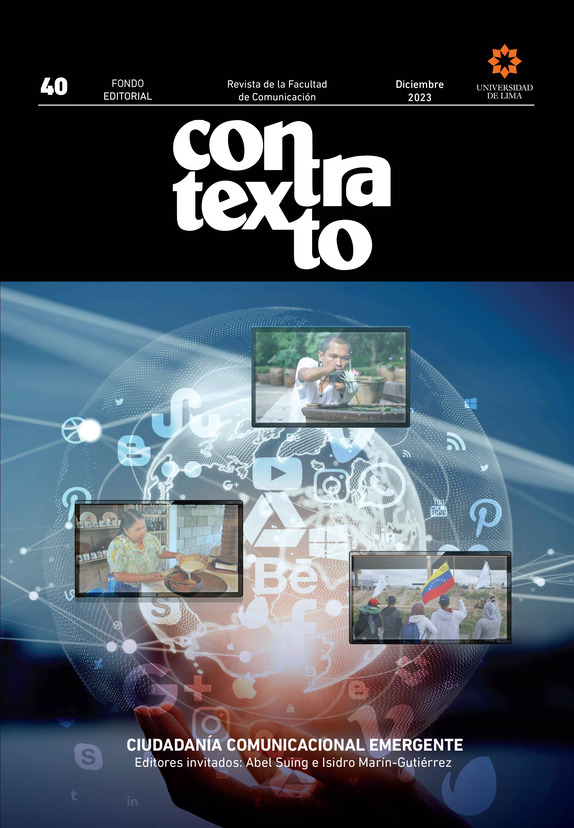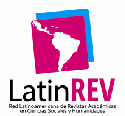¿Están seguros los jóvenes en redes sociales? Diseño de un instrumento para medir la competencia mediática frente a los riesgos de redes sociales
DOI:
https://doi.org/10.26439/contratexto2023.n40.6448Palabras clave:
competencia mediática, jóvenes, medios sociales, peligro, retosResumen
La ciudadanía digital requiere que la población tenga competencias que le permitan navegar de forma segura, saludable y beneficiosa, tomando en cuenta que está continuamente expuesta a peligros en su entorno virtual. El presente artículo presenta una propuesta de herramienta para la evaluación de la competencia mediática cognitiva de jóvenes de 18 a 25 años, frente a los riesgos de redes sociales. Se evalúan aspectos como el conocimiento de los riesgos digitales, la relación de las redes sociales con contravalores y los comportamientos de consumo de contenidos riesgosos. La validación de la herramienta con método Delphi y con la aplicación de una prueba piloto con más de trescientas personas, da muestra de su efectividad para evaluar los aspectos de competencia mediática requeridos para una ciudadanía digital apropiada frente a los peligros del contexto actual.
Descargas
Referencias
Aguaded, I., Marín-Gutiérrez, I., & Caldeiro-Pedreira, M.-C. (2018). Desarrollo de la competencia mediática en el contexto iberoamericano. Revista Letral, (20), 156-182. https://revistaseug.ugr.es/index.php/letral/article/view/7814
Aparicio González, D., Tucho, F., & Marfil-Carmona, R. (2020). Las dimensiones de la competencia mediática en estudiantes universitarios españoles. Icono14, 18(2), 217-244. https://doi.org/10.7195/ri14.v18i2.1492
Aran-Ramspott, S., Fedele, M., & Tarragó, A. (2018). Funciones sociales de los YouTubers y su influencia en la pre adolescencia. Comunicar, 26(57), 71-80. https://doi.org/10.3916/C57-2018-07
Area, M., Gutiérrez, A., & Vidal, F. (2012). Alfabetización digital y competencias informacionales. Fundación Telefónica y Editorial Ariel.
Asselin, C. (2022). TikTok: cifras y estadísticas clave en España, Latam y el Mundo 2022, Social Media Listening and Analytics Blog. Digimind Blog. https://blog.digimind.com/es/agencias/TikTok-cifras-y-estadisticas-2020#temps
Astuti, Y. D. (2021). Digital literacy competence of Indonesian lecturers on analysis hoax in social media. Library Philosophy and Practice. https://digitalcommons.unl.edu/libphilprac/5234
Aventin, Á., Lusher, J., & Sharp, C. A. (2019). Instagram: Friend or foe? An exploratory study of young adults’ perceptions of Instagram. Journal of Youth Studies, 22(1), 115-132. https://www.tandfonline.com/doi/full/10.1080/13676261.2018.1435268
Bennett W. L., & Livingston, S. (2018). The disinformation order: disruptive communication and the decline of democratic institutions. European Journal of Communication, 33(2), 122–139. https://doi.org/10.1177/0267323118760317
Bessell, T. L., McDonald, S., Silagy, C. A., Anderson, J. N., Hiller, J. E., & Sansom, L. N., (2002). Do internet interventions for consumers cause more harm than good? A systematic review. Health Expectations, 5(1), 28-37. https://doi.org/10.1046/j.1369-6513.2002.00156.x
Boyd, D. (2014). It’s complicated. The social lives of networked teens. Yale University Press. https://www.danah.org/books/ItsComplicated.pdf
Cabrera-Hernández, J. I. (2017). Nativos digitales que no lo son tanto. Revista de Estudios de Juventud, 17(117), 199-207. https://bit.ly/3xN2bf0
Cano-Orón, L., & Ruiz, C. (2023). Complementary and alternative medicine on YouTube: an exploratory study of content-creator communities. Contratexto, 39(039), 215-241. https://doi.org/https://doi.org/10.26439/contratexto2023.n39.5723
Cotten, S. R., Ford, G., & Ford, S., Hale, T. (2012). Internet use and depression among older adults. Computers in Human Behavior, 28(2), 496-499. https://doi.org/10.1016/j.chb.2011.10.021
Dame Adjin-Tettey, T. (2022). Combating fake news, disinformation, and misinformation: Experimental evidence for media literacy education. Cogent Arts & Humanities, 9(1). https://doi.org/10.1080/23311983.2022.2037229
Del Prete, A., & Redon Pantoja, S. (2020). Las redes sociales on-line: espacios de socialización y definición de identidad. Psicoperspectivas. Individuo y Sociedad, 19(1), 86-96. https://dx.doi.org/10.5027/psicoperspectivas-vol19-issue1-fulltext-1834
Duggan, J. M., Heath, N. L., Lewis, S. P., & Baxter, A. L. (2011). An examination of the scope and nature of non-suicidal self-injury online activities: implications for school mental health professionals. School Mental Health, 4(1), 1-12. https://onx.la/84def
Eysenbach, G., & Kohler, C. (2002). Does the internet harm health? Database of adverse events related to the internet has been set up. British Medical Journal, (324), 238. https://doi.org/10.1136/bmj.324.7331.238a
Eysenbach, G., & Kummervold, P.E. (2005). Is cyber medicine killing you? The story of a Cochrane disaster. Journal of Medical Internet Research, 7(2), 21. https://doi.org/10.2196/jmir.7.2.e21
Fernández Rodríguez, C., Romero-Rodríguez, L.M. & Puebla Martínez, B. (2021). Cine de la crueldad y plataformas streaming: La erotización de la perversidad en las series mainstream Years and years y Chernobyl. Ámbitos: revista internacional de comunicación, 52, 176-191. https://hdl.handle.net/11441/107671
Ferrés, J., & Piscitelli, A. (2012). La competencia mediática: propuesta articulada de dimensiones e indicadores. Comunicar, (38), 75-82. https://doi.org/10.3916/C38-2012-02-08
Flores González, R., Rodríguez-Estrada, A., & Saldierna, A. R. (2022). Mediaciones en la desinformación que intervienen en la toma de medidas preventivas ante la crisis sanitaria del COVID-19. Contratexto, 38(038), 259-287. https://doi.org/10.26439/contratexto2022.n038.5536
García-Ruiz, R., Gozálvez Pérez, V., & Aguaded Gómez, J. I. (2014). La competencia mediática como reto para la educomunicación: instrumentos de evaluación. Cuadernos.Info, (35), 15-27. https://doi.org/10.7764/cdi.35.623
Giménez, S. (2023). Informe OBS Business School: Redes Sociales, estado actual y tendencias 2023. https://www.obsbusiness.school/actualidad/informes-deinvestigacion/informe-obs-redes-sociales-estado-actual-y-tendencias-2023
González-Fernández, N., Ramírez-García, A., & Salcines, I. (2018). Competencia mediática y necesidades de alfabetización audiovisual de docentes y familias españolas. Educación XXI, 21(2). https://doi.org/10.5944/educxx1.16384
Gutiérrez-Martín, A., & Torrego-González, A. (2018). Educación mediática y su didáctica. Una propuesta para la formación del profesorado en TIC y medios. Revista Interuniversitaria de Formación del Profesorado, 32(91), 15-27. https://bit.ly/2VQIhBE
Harwell, M. R., & Stone, C. A. (2005). The use of a pilot study to improve the quality of a randomized controlled trial. Research in the Schools, 12(2), 27-36.
Hinton, R., & McMurray, I. (2010). How to design and analyse a questionnaire. Health Sciences, (3), 11-17.
Iglesias-Osores, S., & Córdova-Rojas, L. (2021). Poblaciones indígenas amazónicas en la pandemia de COVID-19: Amazonian indigenous populations in the COVID-19 pandemic. Revista Experiencia En Medicina Del Hospital Regional Lambayeque, 7(3). https://doi.org/10.37065/rem.v7i3.540
ISGlobal (2023). ¿Qué impacto tiene en el cerebro adolescente pasar demasiado tiempo frente al móvil? Blog del Instituto de Salud Global de Barcelona.
Keeney, S., Hasson, F., & McKenna, H. (2006). Consulting the oracle: ten lessons from using the delphi technique in nursing research. Journal of Advanced Nursing, 53(2), 205-212. https://doi.org/10.1111/j.1365-2648.2006.03716.x
Kirwil, L. (2009). Parental mediation of children’s Internet use in different European countries. Journal of Children and Media, 3(4), 394-409. https://doi.org/10.1080/17482790903233440
Lange, J., Daniel, J., Homer, K., Reed, M.B., & Clapp, J.D. (2010). Salvia Divinorum: effects and use among YouTube users. Drug and Alcohol Dependence, (108), 138-140. 10.1016/j.drugalcdep.2009.11.010
Lau, A., Gabarron, E., Fernández-Luque, L., & Armayones, M. (2012). Social media in health - What are the safety concerns for health consumers? Health Inf Manag, 41(2), 30-5. 10.1177/183335831204100204
Lewis, S.P., Heath, N.L., St Dennis, J.M., & Noble, R. (2011). The scope of non-suicidal selfinjury on YouTube. Pediatrics, 127(3), 552-557. 10.1542/peds.2010-2317
Linkletter, M., Gordon, K., & Dooley, J. (2009). The choking game and YouTube: A dangerous combination. Clinical Pediatrics, 49(3), 274-279. https://doi.org/10.1177/0009922809339203
Livingstone, S., & Haddon, L. (2009). Introduction. En S. Livingstone & L. Haddon (Eds.), Kids online: opportunities and risks for children (pp. 1-15). The Policy Press. http://eprints.lse.ac.uk/30130/1/Kids_online_introduction_(LSERO).pdf
Livingstone, S., & Helsper, E. (2007). Gradations in digital inclusion: children, young people and the digital divide. New Media & Society, 9(4), 671-696.
Livingstone, S., Ólafsson, K., Helsper, E. J., Lupiáñez-Villanueva, F., Veltri, G. A., & Folkvord, F. (2017). Maximizing opportunities and minimizing risks for children online: the role of digital skills in emerging strategies of parental mediation. Journal of Communication, 67(1), 82-105. https://doi.org/10.1111/jcom.12277
Lotero-Echeverri, G., Romero-Rodríguez, L. M., & Pérez-Rodríguez, M. A. (2018). Factchecking vs. fake news: confirmation journalism as a tool of media literacy against misinformation. Index Comunicación, 8(2), 295-316. https://dialnet.unirioja.es/servlet/articulo?codigo=6459848
Marín-Gutiérrez, I., Rivera-Rogel, D., Mendoza-Zambrano, D., & Zuluaga-Arias, L. I. (2020). Competencia mediática de jóvenes universitarios de Ecuador y Colombia. Trípodos, (46), 97-117. https://doi.org/10.51698/tripodos.2020.46p97-117
Marín-Gutiérrez, I., Rivera-Rogel, D., Velásquez Benavides, A. V., & García Ruíz, R. (2019). Competencias mediáticas en estudiantes universitarios/as de Iberoamérica. Revista Prisma Social, (26), 73-93. https://revistaprismasocial.es/article/view/3027
McIntyre, L. (2018). Post-truth. MIT Press.
Mcgrew, S., Ortega, T., Breakstone, J., & Wineburg, S. (2017). The challenge that’s bigger than fake news: civic reasoning in a social media environment. American Educator, 41(3), 4-9. https://www.aft.org/ae/fall2017/mcgrew_ortega_breakstone_wineburg
McLean Hospital. (2023). The social dilemma: social media and your mental health. Here’s how social media affects your mental health. McLean Hospital. https://www.mcleanhospital.org/essential/it-or-not-social-mediasaffecting-your-mental-health
Mesquita-Romero, W., Fernández-Morante, C., & Cebreiro-López, B. (2022). Critical media literacy to improve students’ competencies. [Alfabetización mediática crítica para mejorar la competencia del alumnado]. Comunicar, (70), 47-57. https://doi.org/10.3916/C70-2022-04
Naciones Unidas. (2015). Combatir la ciberviolencia contra las mujeres y las niñas: una llamada de atención al mundo. Broadband Commission for Sustainable Development.
Núñez Gómez, P., Higuera Brunner, M., Lamelas Ocaña, B., & Estables, M. J. (2016). Competencies and media literacy in primary. Prisma Social, (1), 311-337. https://revistaprismasocial.es/article/view/1323/1387
Ovalle-Quiñones, M., & Vásquez-Tirado, G. A. (2021). Cibercondría: un nuevo ente clínico en el contexto de la pandemia por COVID-19. Revista del Cuerpo Médico del HNAAA, 13b(4), 418-426. https://doi.org/10.35434/rcmhnaaa.2020.134.778
Peña-Fernández, S., Larrondo-Ureta, A. & Morales-i-Gras, J. (2022). Current affairs on TikTok. Virality and entertainment for digital natives. Profesional de la información, 31(1). https://doi.org/10.3145/epi.2022.ene.06
Pérez-Tornero, J. M., Tayie, S. S., Tejedor, S., & Pulido, C. (2018). How to confront fake news through news literacy? State of the art. Doxa Comunicación. Revista Interdisciplinar de Estudios de Comunicación y Ciencias Sociales, (26), 211-235. https://doi.org/10.31921/doxacom.n26a10
Pinker, S. (2011). The better angels of our nature: why violence has declined. Penguin Books. https://www.amazon.com/Better-Angels-Our-Nature-Violence/dp/0143122010
Portillo-Reyes, V. Ávila-Amaya, J. A., & Capps, J. W. (2021). Relación del uso de redes sociales con la autoestima y la ansiedad en estudiantes universitarios. Enseñanza e Investigación en Psicología, 3(1), 139-149. http://cathi.uacj.mx/handle/20.500.11961/19171;jsessionid=667B44522B4C7079B9024460A1B1763E
Ramos-Soler, I., López-Sánchez, C., & Torrecillas-Lacave, T. (2018). Online risk perception in young people and its effects on digital behaviour. Comunicar, 26(56), 71-79. https://doi.org/10.3916/c56-2018-07
Román-García, S., Almansa-Martínez, A., & Cruz-Díaz, M. (2016). Adults and elders and their use of ICTs. Media competence of digital immigrants [Adultos y mayores frente a las TIC. La competencia mediática de los inmigrantes digitales]. Comunicar, (49), 101-110. https://doi.org/10.3916/C49-2016-10
Rosenzweig, A. (2017). Understanding and undermining fake news from the classroom. Berkeley Review of Education, 7(1), 105-117. https://doi.org/10.5070/b87110055
Rowe, G., & Wright, G. (2011). The Delphi technique: past, present, and future prospects - Introduction to the special issue. Technological Forecasting and Social Change, 78(9), 1487-1497. https://doi.org/10.1016/j.techfore.2011.09.002
Serres, M. (2013). Pulgarcita. El mundo cambió tanto que los jóvenes deben reinventar todo: una manera de vivir juntos, instituciones, una manera de ser y de conocer. Fondo de Cultura Económica.
Unesco. (2023). Addressing hate speech through education: a guide for policy makers. https://www.unesco.org/en/articles/addressing-hate-speech-througheducation-guide-policy-makers
Unicef. (2017). Estado mundial de la infancia 2017. Niños en un mundo digital. https://www.unicef.org/ecuador/media/2201/file/Ni%C3%B1os%20en%20un%20mundo%20digital.pdf
Van Deursen, A. J., & Van Dijk, J. A. (2018). The first-level digital divide shifts from inequalities in physical access to inequalities in material access. New Media & Society, 21(2), 354-375. https://doi.org/10.1177/1461444818797082
Vk Muthu. (2021). Violence in social media and its negative impact. The times of India. Readers’ blog. https://timesofindia.indiatimes.com/readersblog/ezhil/violence-in-social-media-and-its-negative-impact-30702/
Wang, Q., Chen, W., & Liang, Y. (2011). The effects of social media on college students. MBA Student Scolarship, paper 5. https://scholarsarchive.jwu.edu/mba_student/5
Wardle, C., & Derakhshan, H. (2017). Information disorder: toward an interdisciplinaryframework for research and policymaking. Council of Europe. https://rm.coe.int/information-disorderreportnovember-2017/1680764666
We Are Social. (2023). Reporte Digital 2023. https://wearesocial.com/es/blog/2023/04/reporte-digital-2023-abril/
Whitlock, J., Lader, W. & Conterio, K. (2007). The internet and self-injury: what psychotherapists should know. Journal of Clinical Psychology, (63), 1135-1143. https://doi.org/10.1002/jclp.20420
Winocur, R. (2013). ¿Estar todo el tiempo conectado vuelve a los ciudadanos más críticos frente al poder y tolerantes con los diversos? En Convergencia y escenarios para una televisión interactiva (pp. 71-84). Productora de contenidos culturales.
Publicado
Número
Sección
Licencia
Todos los trabajos publicados están sujetos a una licencia CC BY 4.0 Creative Commons (actualizado el 1 de marzo de 2021).
El contenido de la revista se puede compartir en cualquier material o formato. Asimismo, se puede adaptar, contribuir y transformar. Ambas posibilidades sólo están permitidas en la medida en que cumplan las siguientes condiciones:
- Atribución: Se debe otorgar crédito donde sea debido, proporcionar un enlace a la licencia e indicar los cambios en caso se realice alguno. Esto debe hacerse de la manera que se considere apropiada, sin sugerir que el licenciante lo promueva a usted o su uso del material.
Derechos de propiedad
Los derechos patrimoniales de Contratexto se publican bajo una licencia Creative Commons BY 4.0, lo que permite a los autores mantener los derechos patrimoniales de su obra sin restricciones.
Si un trabajo publicado en Contratexto fuera copiado, distribuido, difundido o cualquier otra actividad contemplada en la licencia antes mencionada, se deberá mencionar de manera visible y expresa al autor o autores y a la revista.
Auto-archivo
Esta revista permite y anima a los autores/as a publicar artículos enviados a la revista en sus sitios web personales o en depósitos institucionales, tanto antes como después de su publicación en esta revista, siempre y cuando proporcionen información bibliográfica que acredite, si procede, su publicación en ella.


















